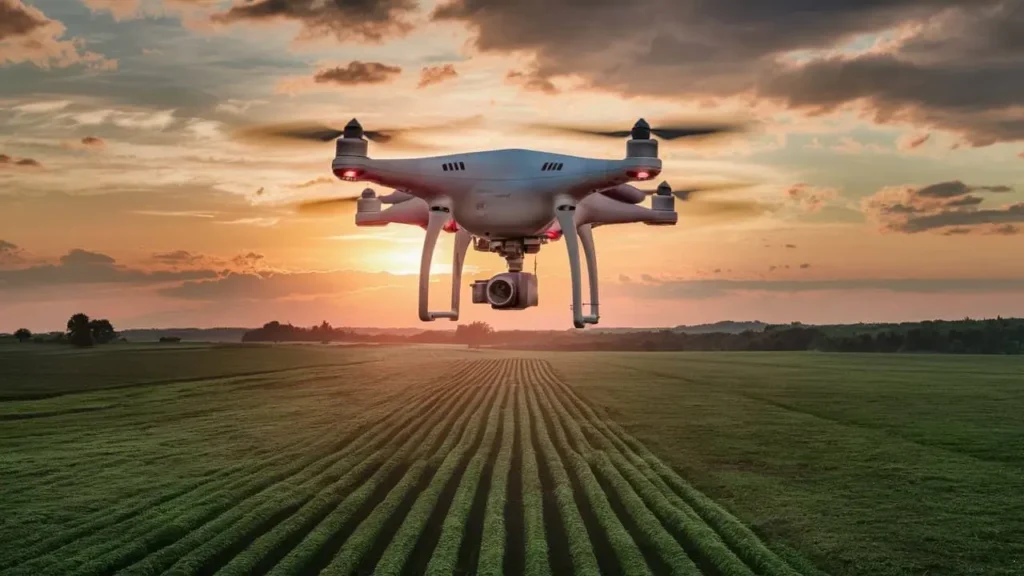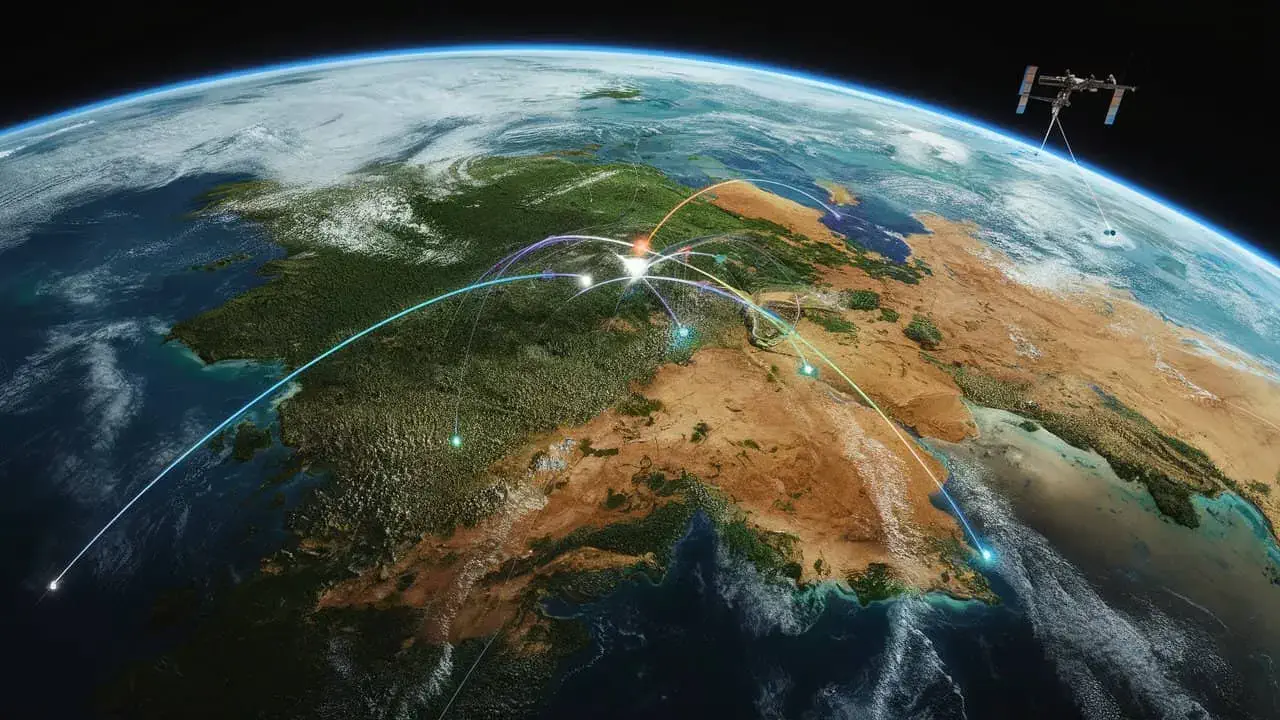As I gaze out the window of a small Cessna aircraft, the patchwork of fields below reminds me of a giant quilt. It’s my first time participating in an aerial survey, and I’m struck by how different everything looks from up here. The pilot, a seasoned remote sensing specialist, points out features I would have missed – subtle changes in crop health, hidden archaeological sites, and the creeping fingers of urban sprawl.
This bird’s-eye view is just a taste of what remote sensing can reveal. But what exactly is remote sensing, and why should you care? Let’s embark on a journey to uncover the fascinating world of Earth observation and its profound impact on our understanding of our planet.
Demystifying Remote Sensing: More Than Just Pretty Pictures
At its core, remote sensing is about gathering information from a distance. It’s like being a detective with a really, really long magnifying glass. While the term might conjure images of high-tech satellites, remote sensing encompasses a broad range of techniques and technologies.
Dr. Sarah Chen, a remote sensing expert at the University of California, Berkeley, explains it this way: “Remote sensing is our eyes and ears for understanding Earth’s systems. It allows us to observe processes and patterns that would be impossible to see from the ground.”
The Electromagnetic Spectrum: Nature’s Hidden Rainbow

To truly grasp remote sensing, we need to understand the electromagnetic spectrum. It’s not just about what we can see with our eyes – there’s a whole world of invisible energy out there.
Imagine you’re at a concert. The visible light is like the music you can hear, but there’s also subsonic bass you can feel and ultrasonic frequencies beyond human perception. The electromagnetic spectrum is similar – visible light is just a small part of it.
Remote sensing taps into different parts of this spectrum:
- Visible light tells us about land cover and ocean color
- Near-infrared reveals plant health
- Thermal infrared detects heat signatures
- Microwave penetrates clouds and can even see through some surfaces
Each of these “colors” in nature’s rainbow provides unique insights into our planet’s workings.
Active vs. Passive: To Beam or Not to Beam
Remote sensing systems come in two flavors: passive and active. Passive systems are like cosmic eavesdroppers, quietly listening to the energy naturally emitted or reflected by the Earth. Think of them as nature’s paparazzi, always ready to capture the Earth’s candid moments.
Active systems, on the other hand, are more like interstellar interrogators. They beam down energy and analyze what bounces back. It’s like playing a planetary game of Marco Polo.
Dr. Chen adds, “Active systems like radar can peer through clouds and even penetrate surfaces, revealing hidden structures and movements. They’re invaluable for monitoring things like ice sheet dynamics and tectonic activity.”
The Eyes in the Sky (and Beyond)

Remote sensing platforms are as diverse as the data they collect. From satellites orbiting hundreds of miles above Earth to drones buzzing just above treetops, each offers a unique perspective on our planet.
Satellites: The Silent Sentinels
Satellites are the workhorses of remote sensing. They tirelessly circle the Earth, capturing images and data day and night. But not all satellites are created equal.
Geostationary satellites hover like cosmic security cameras, always watching the same spot. They’re perfect for monitoring weather patterns or tracking ship movements.
Polar-orbiting satellites, on the other hand, are more like celestial scanners. They circle from pole to pole, gradually building up a complete picture of the entire planet.
Fun fact: The International Space Station is also used for remote sensing. Astronauts up there have captured some of the most stunning and scientifically valuable images of Earth ever taken.
Aircraft: The Versatile Surveyors
While satellites offer a global view, aircraft provide a happy medium between space-based and ground observations. They’re like the Swiss Army knives of remote sensing – versatile and adaptable.
I remember my first time in a remote sensing aircraft. The pilot, a grizzled veteran named Jack, regaled me with stories of mapping ice sheets in Antarctica and tracking oil spills in the Gulf of Mexico. “Up here,” he said, “you get a whole new appreciation for the planet. And sometimes, you see things that change the way scientists think about Earth processes.”
Drones: The New Kids on the Block
Unmanned Aerial Vehicles (UAVs) or drones have revolutionized remote sensing in recent years. They’re like the punk rockers of the remote sensing world – nimble, a bit rebellious, and changing the game.
Dr. Elena Rodriguez, a drone specialist at the Spanish National Research Council, shares her excitement: “Drones allow us to collect incredibly detailed data at a fraction of the cost of traditional methods. We’re using them to monitor endangered species, assess crop health, and even detect archaeological sites hidden beneath the soil.”
Ground-Based Systems: Keeping Our Feet on the Ground
Not all remote sensing happens from above. Ground-based systems play a crucial role in validating satellite and aerial observations. They’re the fact-checkers of the remote sensing world.
From weather radars to seismic sensors, these systems provide a ground truth that helps scientists interpret the data collected from above. It’s a perfect example of how remote sensing often requires a multi-pronged approach to uncover Earth’s secrets.
Remote Sensing in Action: Real-World Applications
Remote sensing isn’t just about collecting data – it’s about using that data to make a difference. Let’s explore some of the ways this technology is changing our world.
Environmental Monitoring: Earth’s Health Check
Remote sensing has become an indispensable tool for environmental scientists. It allows us to keep tabs on the health of our planet in ways that were once unimaginable.
Take the Amazon rainforest, for example. Satellite imagery has revealed the true extent of deforestation, leading to international efforts to protect this vital ecosystem. Matt Hansen, a professor at the University of Maryland, led a team that used Landsat data to create the first high-resolution maps of global forest change. “What we found was shocking,” Hansen says. “We were able to quantify forest loss and gain at a scale never before possible.”
But it’s not just about forests. Remote sensing helps us monitor air and water quality, track the spread of invasive species, and even predict natural disasters before they happen.
Agriculture: Farming from Above
Farmers are increasingly looking to the sky to improve their yields and reduce their environmental impact. Precision agriculture, powered by remote sensing, is transforming the way we grow food.
John Deere, the agricultural equipment manufacturer, now offers services that use satellite and drone imagery to help farmers make decisions. From determining optimal planting times to identifying areas that need more or less water, remote sensing is helping to make agriculture more efficient and sustainable.
Sarah Johnson, a farmer in Iowa, shares her experience: “At first, I was skeptical. But after using satellite data to guide our fertilizer application, we saw a 15% increase in yield and a significant reduction in runoff. It’s good for our bottom line and good for the environment.”
Urban Planning: Building Smarter Cities

As our cities grow, remote sensing is helping urban planners make smarter decisions about development and resource management.
Singapore, often hailed as a “smart city,” uses remote sensing extensively in its urban planning. By combining satellite imagery with ground-based sensors, the city-state has created a detailed 3D model of the entire island. This “digital twin” helps planners optimize everything from solar panel placement to traffic flow.
Disaster Management: Responding to Nature’s Fury
When disaster strikes, remote sensing provides critical information for response and recovery efforts. From mapping the extent of wildfires to assessing damage after earthquakes, this technology saves lives and helps communities rebuild.
Dr. Linlin Ge, a remote sensing expert at the University of New South Wales, recalls using satellite radar data to map ground deformation after the 2011 Christchurch earthquake in New Zealand. “We were able to detect movements as small as a few millimeters across the entire city,” Ge explains. “This information was crucial for identifying areas at risk of further damage and guiding reconstruction efforts.”
Climate Change Studies: Tracking Global Transformations
Remote sensing has become an indispensable tool in the study of climate change, offering a global perspective on our planet’s shifting patterns.
Dr. Claire Parkinson, a climate scientist at NASA’s Goddard Space Flight Center, explains: “Satellite observations have revolutionized our understanding of climate change. We can now track changes in ice sheets, sea levels, and atmospheric composition with unprecedented accuracy and coverage.”
One of the most critical applications is monitoring ice sheets in polar regions. Using a combination of optical and radar satellites, scientists can measure not just the extent of ice cover, but also its thickness and movement.
“What we’re seeing is alarming,” says Dr. Eric Rignot, a glaciologist at the University of California, Irvine. “Satellites have revealed that ice sheets in Greenland and Antarctica are losing mass at an accelerating rate. This data is crucial for refining our climate models and projecting future sea level rise.”
But it’s not just about ice. Remote sensing allows us to observe a wide range of climate indicators:
- Ocean temperature and currents
- Changes in vegetation patterns
- Atmospheric carbon dioxide levels
- Urban heat island effects
The power of remote sensing in climate studies lies in its ability to provide consistent, long-term global observations. “We can now see how different parts of the Earth system interact,” Dr. Parkinson adds. “For example, we can track how changes in ocean temperature affect weather patterns, or how deforestation impacts local climates.”
This global perspective is helping to build a more comprehensive understanding of climate change, informing policy decisions and mitigation strategies. As we face the challenges of a warming planet, the view from above may be our best tool for charting a sustainable path forward.
The Road Ahead: Challenges and Opportunities
As exciting as remote sensing is, it’s not without its challenges. But these challenges are driving innovation and shaping the future of the field.
Big Data: Drowning in Information
The sheer volume of data being collected by remote sensing platforms is staggering. NASA’s Earth Observing System Data and Information System (EOSDIS) alone archives about 16 terabytes of data every day – that’s equivalent to about 4,000 high-definition movies!
Managing, processing, and analyzing this data requires advanced computing capabilities and innovative approaches. Cloud computing platforms like Google Earth Engine are revolutionizing how we handle big geospatial data, allowing researchers to analyze petabytes of satellite imagery with unprecedented ease.
Artificial Intelligence: Teaching Machines to See
AI and machine learning are transforming remote sensing analysis. These technologies allow us to automate image classification, detect subtle patterns, and even predict future changes based on historical trends.
Dr. Yoshua Bengio, a pioneer in deep learning, sees enormous potential in applying AI to remote sensing data. “We’re just scratching the surface of what’s possible,” Bengio says. “AI could help us detect early warning signs of environmental change, improve our weather forecasting, and even discover new archaeological sites.”
Ethical Considerations: With Great Power Comes Great Responsibility
As remote sensing technology becomes more powerful and accessible, it raises important ethical questions. How do we balance the benefits of Earth observation with privacy concerns? Who should have access to this data, and how should it be used?
These are questions that society will need to grapple with as remote sensing continues to advance. It’s a reminder that with great technological power comes great responsibility.
Conclusion: A New Perspective on Our Home
As we’ve journeyed through the world of remote sensing, I hope you’ve gained a new appreciation for this incredible technology. From the Cessna I flew in to the satellites orbiting high above, remote sensing is providing us with an unprecedented view of our planet.
But remote sensing is more than just a tool for scientists and researchers. It’s a window into the complex workings of our Earth, offering insights that can help us make better decisions about how we manage our resources, develop our cities, and protect our environment.
As we face global challenges like climate change, food security, and sustainable development, remote sensing will play an increasingly crucial role in finding solutions. And who knows? The next breakthrough in understanding our planet might come from someone inspired by the view from above.
So, the next time you look up at the sky, remember that there’s a whole network of eyes looking back down, helping us to better understand and care for our beautiful blue planet. And perhaps, like me on that first flight, you’ll be inspired to see the world in a whole new way.
What aspect of remote sensing fascinates you the most? How do you think this technology might shape our future? Share your thoughts in the comments below, and let’s continue this exciting exploration of Earth’s secrets from above!
Note: This article is intended to provide a general introduction to remote sensing. For specific applications or technical details, please consult professional remote sensing resources or experts in the field.

